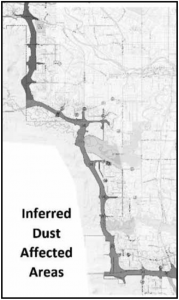
Like most of the region’s commuters, I really look forward to the faster commute when the South West Ring Road opens, in late 2021. Until then, I endure construction dust, invading my car, previously my home and my family’s lungs.
Only once I started my research on construction dust issues, I realized that Calgary’s west side communities have been petitioning long term for solutions to mitigate the construction dust. Realistically, this dust affects many communities within a reasonable proximity of construction, pit or road – dryness and wind are great for spreading the dust around. I recently experienced dust storms impairing my visibility while driving on Glenmore.

Dusts are tiny solid particles scattered or suspended in the air. The particles are “inorganic” or “organic,” depending on the source of the dust. Inorganic dusts can come from grinding minerals such as rock or soil. Examples of inorganic dusts are silica, asbestos, and coal. Organic dusts originate from plants or animals. An example of organic dust is dust that arises from handling grain. These dusts can contain a great number of substances. Aside from the vegetable or animal component, organic dusts may also contain fungi or microbes and the toxic substances given off by microbes.
I also like to educate. We all like to breathe. The dust produced at construction sites can lead to respiratory illnesses which eventually may be irreversible. According to research, principal risks of inhaling construction dust includes:
- Asthma – when dust and fumes are inhaled, it has the potential to damage lungs. Some common symptoms of Asthma include wheezing, breathlessness and painful coughing, as well as heaviness and tightness in the chest.
- COPD – is a grouping of different types of breathing problems generally caused by the inhalation of dust, chemicals, gases and fumes; it results in either long term cough or damage to lungs.
- Silicosis – is rare to an average person; on the other hand, 380,000 Canadians are occupationally exposed to silica through construction trades (www.ccohs.ca/oshanswers/diseases/silicosis.html), the majority of those at risk being construction workers, heavy equipment operators, and plasterers or drywallers. Silicosis is permanent lung damage caused by breathing in dust containing respirable crystalline silica, found largely in sands, clay, and stone.
Is this concerning? In my opinion, yes. I like to breathe easy. Should we stop progress, like stop road construction? No. I look forward to our new, less busy road. After my research, I will however improve the air filters in my home and car.
By Carla Berezowski
with parts adapted from www.cadrillers.com and www.ccohs.ca


























